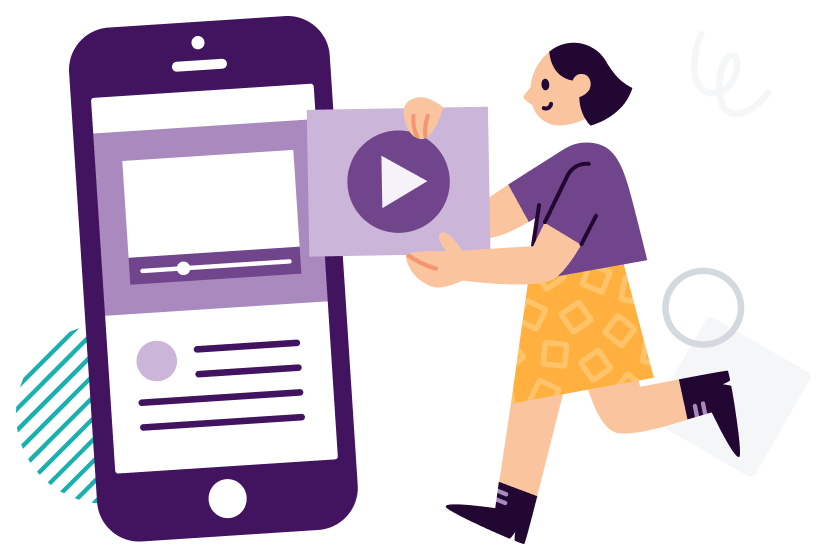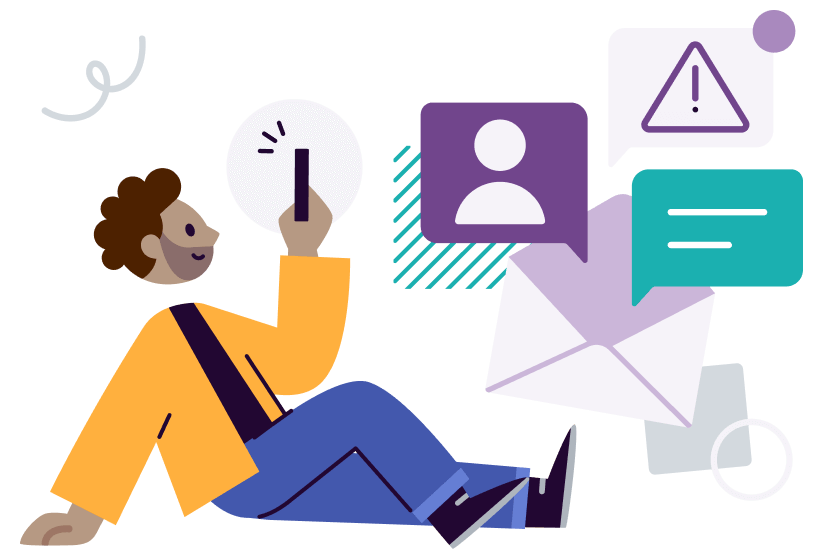RCS messaging 101: Your quick start guide
What is RCS messaging and how can businesses use it to its fullest potential? Read more about this messaging channel’s key features and functionalities, the different ways to use RCS, tips on choosing the right RCS provider and more.

Welcome to RCS, the evolution of SMS
Consumer preferences and demands are changing and we now all expect to receive richer and more interactive messages which is where RCS comes in. RCS, which stands for Rich Communication Services, offers a rich, immersive messaging experience similar to WhatsApp and Facebook Messenger. Send and receive not only texts but images, videos, voice recordings and location pins as well.
Built on top of the existing SMS channel (so there’s no need to download a separate app), RCS is essentially seen by many as the next stage of the evolution of SMS.
As long as your phone is RCS-enabled, you’ll be able to send and receive RCS messages. If not, your message will be converted to an SMS message.
For businesses, this unlocks a world of possibilities. Provide customers with a rich messaging experience that they can access via their mobile’s built-in messaging app – helping you to enhance customer engagement and experience. You can also benefit from a branded business profile and brand verification, which boosts customer trust.
While it’s currently only available on Android devices, Apple has announced that it will adopt the RCS messaging standard in late 2024. So finally, iPhone and Android users can exchange rich messages and engage with interactive features like typing bubbles and read receipts without needing to download another app. All they need is an internet connection, whether that’s WiFi or mobile data.
Want to find out more about RCS? Look no further than this resource, where we’ll be breaking down the features and functionalities, top ways to use RCS and how businesses can use it to supercharge their engagement with customers.
A closer look at RCS: Features & functionalities
Did you know that 90% of consumers want to interact with brands via text messages? And 86% of these consumers feel more positive about that brand after messaging them. With RCS, you can meet these expectations. Not only can you have two-way interactions with consumers but you can also share richer, more engaging messages.
Here are some of the top features that RCS messaging enables.
- Branding – Including branding, such as your logo, brand name and colours, helps to improve customer trust.
- Verified sender – In addition to branding, a verified tick boosts customer confidence and trust.
- Rich media – The addition of rich media like images, videos, GIFs and emojis means more engaging and memorable messages can be sent.
- QR code – Great for tickets, discount codes or website call-to-actions, QR codes add an extra layer of interactivity.
- Reply buttons – Customised reply buttons help to aid conversation and make communication quick and easy.
- Reporting – Real-time read and delivery receipts enhance campaign tracking.


The difference between an SMS message (left) and an RCS message (right)
Your business will also benefit from:
- Access to message templates
Choose from text-based, interactive or call-to-action. - Security
RCS offers end-to-end encryption and regulations for universal profiles ensure that every experience is the same across all networks and countries.
The different types of RCS messages
There are three types of RCS messages:
- Branded messages
Upgrade existing SMS traffic with verified branding and improved security. - Single messages
Embed rich content into your messages and boost engagement and conversion. - Conversations
Have two-way chats with customers – perfect for sales, customer service, marketing and more.
These messages can help you:
- Drive revenue through increased engagement and new, high-value use cases.
- Reduce costs by replacing or streamlining costly and unpopular customer care calls.
- Enable campaign optimisation through better data and metrics, including delivery rates and read receipts.
SMS vs RCS
Where SMS offers unrivalled reach, RCS offers you the opportunity to craft a richer, more engaging experience, thanks to the ability to add high-res images, GIFs, videos and more. Which one should your business choose?
How to use RCS

1. Rich notifications
Reminders will not only keep your customers informed but can also help them to manage important notes – such as reminders.
Example applications include:
- Order confirmations
- Delivery updates
- Appointment reminders
- Service interruptions
2. Marketing
When you send marketing campaigns through RCS, you benefit from the ability to send rich, engaging content which can help you boost read rate, conversion and the overall user experience.
Example applications include:
- Flash sales
- Product launches
- Upsells
- Driving website traffic


3. Customer support
RCS can resolve support queries faster and create improved experiences for customers.
Example applications include:
- Account updates
- Order queries
- FAQs
- Contract/policy updates
4. Alerts
One of the most popular and effective ways to use mobile messaging is to send alerts to customers, informing them of status updates, IT notifications and more. With RCS, your business can improve customer experience, and gather better metrics and analytics data on campaigns.
Example applications include:
- Travel updates
- Facility closures
- Security breaches
- Account updates


5. Sales
From rearranging appointments to processing payments, handling common queries can be time-consuming and take resources away from the cases that really require human intervention. A chatbot delivered via RCS can not only solve this challenge, but also give customers the power to serve themselves, eliminating the need to speak to a support agent or experience delays in the process as a result of being put on hold.
Example applications include:
- Appointment booking and management
- Order updates
- Account management
- Answering FAQs
Case study: Southwark Council
Southwark Council wanted to capitalise on their success with SMS campaigns for those in early arrears on their council tax. With an existing campaign engagement rate of 32%, Southwark planned to increase engagement levels and looked at RCS as an option because it provided the opportunity to build in suggested replies and calls to action that SMS alone could not provide.
By incorporating RCS into their communication strategy, Southwark Council saw:

- A 55% increase in people choosing to make a payment, up from 21%.
- A 60% increase in people choosing to engage with the customer service team for support.
- 90% of people stating this was a better experience than SMS, in addition to making customers feel more reassured.
Want to keep learning how other businesses are using RCS and rich messaging to boost their customer experience?
Head over to our case studies page to be inspired!
Choosing an RCS provider
Once you’re ready to implement RCS into your business communication strategy, your next step is to choose the right provider. Here are some areas to consider.
Highly experienced
Has your RCS provider worked with businesses like yours? This could be in terms of project scope, business size or they’ve worked with organisations in the same industry as you. The best providers will also be experienced in implementing mobile messaging solutions as a whole so they can help you to decide where it’s best to use RCS in addition to your existing comms channels for maximum ROI.
At Esendex, we’ve been helping our customers benefit from mobile-focused communication strategies for over 20 years. We’re also committed to learning about and investing in future developments in business messaging so you don’t have to. That means we can help you stay one step ahead of the competition.

Customer-centric approach
Can your RCS provider respond proactively when your business needs change? This may mean implementing RCS in a way that’s best for your organisation or recommending a different messaging approach that might be better suited.
For example, Esendex will take the time to understand your business, from challenges to goals, so we can help you select the right mobile messaging solution for your needs. That includes bespoke solutions and integrations.
RCS feature set
Some key RCS features include high-quality media sharing, interactive buttons, read receipts and message performance reports. What features can your prospective RCS provider offer?
The Esendex messaging studio platform is included as part of our RCS offering. So in addition to features like branded business profiles, access to suggested replies, interactive buttons, images and other media, you can also:
- Manage multiple conversations from a centralised location.
- Use the Template Builder to create rich message templates – perfect for business-initiated chats. Drag and drop elements such as images, videos, PDFs and call-to-action buttons.
- Send your rich content messages via various channels, from RCS to SMS and WhatsApp.
Interoperability
Can your RCS provider support interoperability across different types of devices and operating systems? This means your RCS messages can be sent and received by a wide range of users.
Esendex will first identify whether the recipient’s device can receive RCS messages. If the device is RCS-compliant, the rich message will be delivered directly into the default messaging app on the recipient’s phone – just like a standard SMS.
If the device isn’t RCS-compliant, the recipient will receive an SMS landing page message so they still receive the rich experience you intended.

Integration capabilities
The ability to integrate with your existing systems, such as your CRM solution or any other messaging platforms, is key to a smooth RCS implementation. What seamless integration solutions or APIs does your provider offer?
Enabling business messaging is quick and easy with Esendex. Our Rich Content API allows you to integrate message sending capabilities into your existing systems. So within minutes, you can start sending RCS messages.
Level of support
As your business grows, your messaging requirements may do so too. Can your RCS provider scale its services and support to align with your changing needs?
At Esendex, we’re committed to maintaining strong customer relationships. That’s why we offer 24/7 support to every customer. No tiered pricing, no hidden costs. We strive to be the expert partner you can rely on.
Are you ready to get started?
Ready to start your RCS journey with Esendex? Get in touch with us today.
